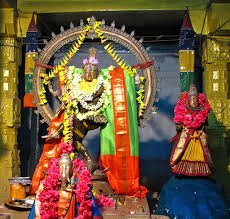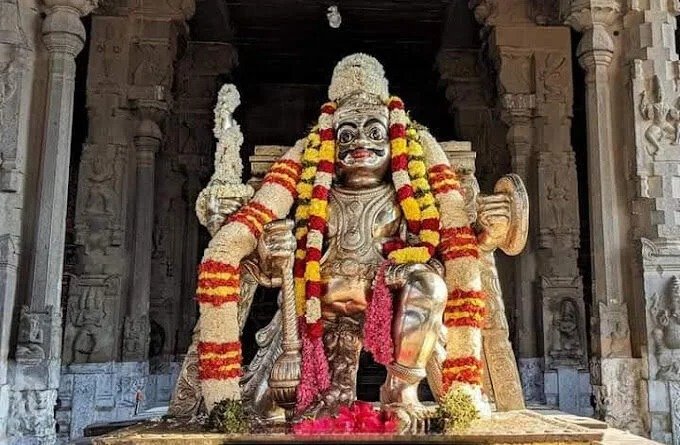Ekambareswarar/Ekambaranathar Temple Tamil Nadu
Ekambareswarar Temple (Ekambaranathar Temple) is a Hindu temple dedicated to the god Shiva, located in the town of Kanchipuram in Tamil Nadu, India.
t is significant to the Hindu sect of Saivism as one of the temples associated with the five elements, the Pancha Bhoota Stalas, and specifically the element of earth, or Prithvi. Shiva is worshiped as Ekambareswarar or Ekambaranathar or Rajlingeswaram, and is represented by the lingam as Prithvi lingam. His consort Parvati is depicted as Elavarkuzhali.
The presiding deity is revered in the 7th century Tamil Saiva canonical work, the Tevaram, written by Tamil saint poets known as the nayanars and classified as Paadal Petra Sthalam.
The temple complex covers 10 hectares (25 acres), and is one of the largest in India. It houses four gateway towers known as gopurams. The tallest is the southern tower, with 11 stories and a height of 58.5216 m (192 ft), making it one of the tallest temple towers in India. The temple has numerous shrines, with those of Ekambareswarar and the Vishnu shrine – Nilathingal Thundam Perumal (a Divyadesam)
being the most prominent. The temple complex houses many halls; the most notable is the thousand-pillared hall built during the Vijayanagar period.
The temple has six daily rituals at various times from 3:30~4:00 a.m. to 10 p.m., and twelve yearly festivals on its calendar. Panguni Uthiram festival celebrated for thirteen days during the Tamil month of Panguni (March – April) is the most prominent festival of the temple and the town.The present masonry structure was built during the Chola dynasty in the 9th century, while later expansions are attributed to Vijayanagar rulers. The temple is maintained and administered by the Hindu Religious and Charitable Endowments Department of the Government of Tamil Nadu. The temple is the largest and one of the most prominent tourist attractions in the city.
Legend
Legend has it that once Parvati, the consort of Shiva, wanted to expiate herself from sin by doing penance under a mango tree near Vegavati river.In order to test her devotion Shiva sent fire on her. Parvati prayed to the god Vishnu. Vishnu brought the Moon whose rays cooled down the tree and Parvati. Shiva again sent the river Ganga (Ganges) to disrupt Parvati’s penance. Parvati convinced Ganga that since they were sisters, she should not harm Parvati. Parvati worshipped a Shiva Linga out of sand to please Shiva. Ultimately, Shiva appeared before her as Ekambareswarar or “Lord of Mango Tree”.
According to another legend, Parvati worshipped Shiva in the form of a Prithvi Lingam (or a Lingam out of sand), under a mango tree.
Legend has it that the Vegavati river overflowed, threatening to engulf the Shiva Lingam; Parvati as Kamakshi embraced the Lingam. Shiva touched by the gesture materialized in person and married her. In this context he is referred to as Tazhuva kuzhainthaar (“He who melted in Her embrace”) in Tamil.
Tirukuripputhonda Nayanar, a nayanar saint, was a washerman near the temple and he washed the clothes of all the Saivities. He was divinely tricked by Shiva appearing as an aged brahmin and asked him to wash before dawn. At the same time, Shiva made a cloudly evening. On observing the approach of the evening, the washerman banged his head in a stone in disappointment. God appeared in his true form and graced his devotee.
History
This vast temple is one of the most ancient in India having been in existence since at least 600 CE. Second-century-CE Tamil poetry speaks of Kama kottam, and the Kumara kottam (currently the Kamakashi Amman temple and the Subramanya temple). The temple finds mention in the classical Tamil Sangam literature dated 300 BCE like Manimegalai and Perumpāṇāṟṟuppaṭai. Initially temple was built by Pallavas. The Vedantist Kachiyapper served as a priest at the temple. The existing structure then, was pulled down and rebuilt by the later Chola Kings. Adi Sankara, the 10th-century saint got Kanchipuram remodelled along with expansion of this temple along with Kamakshi Amman temple and Varadaraja Perumal Temple with the help of local rulers.
There are inscriptions dated 1532 CE (record 544 of 1919) indicating the gift of number of villages made by Achutaraya.Vira Narasingaraya Saluva Nayaka who was directed by Achutaraya broke the royal order by giving more lands to Ekambaranathar temple than the Varadaraja Swamy temple against the instruction of an equal gift to either of the temples. Achutaraya on hearing this equally distributed the lands to both the temples.The eleven-storied southern gopuram, built by Krishnadevaraya (1509-29), is 57 m (187 ft) tall and is one of the tallest gopurams in the country.
The Vijayanagar kings, during the 15th century, also made lot of contributions to the temple and later developed by Vallal Pachiyappa Mudaliar used to go regularly from Chennai to Kanchipuram to worship in this temple, he spent significant money he amazed during British rule on the temple renovation, Pachiyappa Mudaliar seated at horse back can be seen in the temple pillar. At the later stage a similar temple with same name Ekambareswarar was constructed in Chennai by Pachiappa Mudaliar in order to avoid travelling time to Kanchipuram. The Archaeological Survey of India report of 1905–06 indicates widespread renovation activities carried out in the temple by Nattukottai Chettiars. In modern times, the temple is maintained and administered by the Hindu Religious and Charitable Endowments Department of the Government of Tamil Nadu.

















